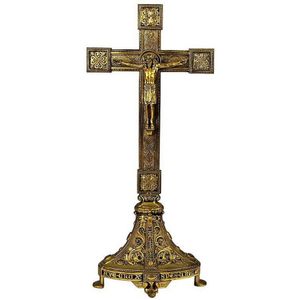Empire Maiden Candelabra Pair
You must be a subscriber, and be logged in to view price and dealer details.
Subscribe Now to view actual auction price for this item
When you subscribe, you have the option of setting the currency in which to display prices to $Au, $US, $NZ or Stg.
- Bronze - An alloy of copper and tin, traditionally in the proportions of about 9 parts of copper to 1 part of tin.
The discovery of bronze in Western Asia in the 4th century enabled people to create metal objects which were superior to those previoulsy possible because of its strength and hardness, and it has been used throughout the world for weapons, coins, tools, statuary and other decorative items.
It is very fluid in a molten state, and its hardness, strength when set, and non-corrosive properties makes it most suitable for casting sculpture. - Ormolu - Ormolu was popular with French craftsmen in the 18th and 19th century for ornamental fittings for furniture, clocks and other decorative items. True ormolu is gilt bronze, that is bronze that has been coated with gold using a mercury amalgam. Due to the health risks associated with using mercury, this method of creating ormolu was discontinued in France in the 1830s. A substitute was developed consisting of about 75% copper and 25% zinc, however it was inferior to the bronze version. It was often lacquered to prevent it tarnishing.
- Anthemion - An anthemion is a classical decorative design element based on the acanthus flower that consists of a central circular or oval motif surrounded by radiating petals or leaves. It is often used as a border or frieze in architecture, furniture, and other decorative arts. The anthemion is derived from the palmette, a motif that was popular in ancient Greek and Roman art and architecture. It is often associated with the classical world and with Neoclassical style, and it is often used to add a sense of grandeur and formality to a design. The anthemion is also known as a honeysuckle or honeysuckle ornament. It continues to be used in a variety of contexts today, and it is often admired for its elegant and decorative qualities.
This item has been included into following indexes:
-
candelabra / candelabrum
- gilt and gold 179
- ormolu and bronze 192
- pairs and garnitures 520
Visually similar items

A pair of ebonized bronze candelabra modelled as winged goddesses, French, 19th century, on marble base, 66 cm high

A lady's 18ct gold vintage wrist watch; with white dial, Roman indicators, 17 jewel movement (not working) to a gate link stretch bracelet. London 1919. Wt. 30.5g.

A pair of Napoleon III ormolu and marble candlesticks, circa 1870s, the pillar sticks with cast foliate sconces and frilled dishes, the black marble columns with foliate capitals and laurel leaf bases, raised on stepped square black marble bases with pink

Gilded brass ornate crucifix in the Gothic style, with mark. Height 41 cm
